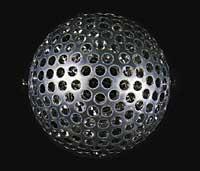The earth moves the space
Although the General Theory of Relativity has surprising consequences, not all have yet been tested. But one of them is: Lense-Thirring effect. For this purpose, the satellites LAGEOS I and LAGEOS II have measured in detail the gravitation of the Earth.

According to the Lense-Thirring effect, a large mass, when turning, deforms the surrounding space as if dragging. However, this effect only stands out when the masses are very large, as in the planets or stars. Physicists have wanted to know if it is also reflected on Earth, and for this purpose they have measured gravitation from the two satellites in recent years.
If we measured gravity with great precision, they should find some indication of deformation of space. And so it has happened, even though these tracks are tiny and the measurement error is very large.
The measurement has been difficult, since in addition to being a small effect, the mass of the Earth is not distributed in a homogeneous way, so the gravity it causes is not the same in all places. However, physicists have managed to know that the Earth produces two meters of deformation a year in the surrounding space.





